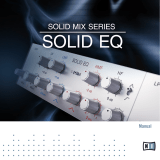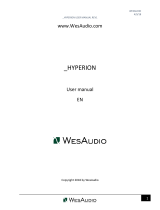Page is loading ...

Super-Analogue™ Outboard
X-Rack EQ User’s Guide
This documentation package contains the User’s Guide for your new X-Rack EQ module.
Depending on the age of your X-Rack, these pages may already be present in your X-Rack
Owner’s Manual – please check to see if these pages match your Manual. If they do not,
these pages should be filed alongside it.
Note. There may be a newer version of the X-Rack Owner’s Manual available for download from our
website ( http://www.solidstatelogic.com
)
82S6XR0B0B
Solid State Logic
S O U N D
||
V I S I O N
SUPERANALOGUE
X - R A C K


Page B-1
X-Rack EQ Module
B. EQ Module
B.1 Connection
The module input and output gains can be set to operate at a nominal level of either
+4dBu or –10dBV, using a switch on the connector panel. To select the appropriate
level for the equipment you are connecting to, please check the operating manual for
your mixer or DAW. The switch should be released for +4dBu operation: push it in for
–10dBV operation.
B.2 Operation
The EQ module is a 4-band equaliser that can be switched between two different
sets of curves, one based on the latest version of the classic SSL E Series EQ and the
other based on SSL’s G Series EQ.
The G-EQ button switches the EQ from ‘E’ operation to ‘G’ operation.
The IN button switches the entire section in and out of circuit.
B.2.1 Frequency Sections
The different frequency sections are as follows:
HF Section: Frequency range 1.5kHz – 22kHz
Gain ±20dB
LF Section: Frequency range 40Hz – 600Hz
Gain ±16.5dB
The HF and LF sections provide shelving equalisers with variable turnover
frequency and a gentle slope. Selecting the ‘G-EQ’ button provides a slightly steeper
slope for both sections with a degree of overshoot/undershoot (depending on
whether you are boosting or cutting) below the selected HF frequency (or above the
selected LF frequency). Selecting ‘ ’ (‘Bell’) in either mode switches the equaliser
to a peaking curve.
HMF Section: Centre frequency 600Hz – 7kHz
Gain ±20dB
Continuously variable Q (0.7 – 2.5)
LMF Section: Centre frequency 200Hz to 2.5kHz
Gain ±20dB
Continuously variable Q (0.7 – 2.5)
Normally, the bandwidth of the HMF and LMF sections will remain constant at all
gains – at lower gains the EQ curves are comparatively narrower for a given Q
setting. This is particularly useful for drums since relatively high Q is available at low gain settings but is
less suitable for overall EQ or subtle corrections because the Q must be adjusted to maintain the same
effect as the gain is changed.
When the EQ is switched to ‘G-EQ’ operation, the bandwidth will vary with gain so an increase in boost
or cut increases the selectivity of the EQ. This type of EQ can sound most effective when used at moderate
settings; the gentle Q curve lends itself to the application of overall EQ on combined sources and subtle
corrective adjustments to instruments and vocals.
2
1
SEL
X
R625
H
F
d
B
H
MF
L
MF
dB
dB
LF
dB
Q
Q
-
+
- +
- +
- +
IN
G
-EQ
KHz
KHz
22 1.5
10 5
2
15
7.6
32
1 5
Hz
KHz
2.0 .2
1.0 .6
.3 1.6
600 40
220
60
OUT
IN
+
4dBu
-10dBV
1
2

Page B-2
X-Rack Owner’s Manual

Page B-3
X-Rack EQ Module
B.3 Performance Specification
The following pages contain audio performance specification figures for the X-Rack EQ Module. No other
Solid State Logic products are covered by this document and the performance of other Solid State Logic
products can not be inferred from the data contained herein.
B.3.1 Measurement Conditions
For each set of figures on the following pages, the specific unit and test setup will be stated at the
beginning of that section. Any changes to the specified setup for any particular figure(s) will be detailed
beside the figures to which that difference applies.
B.3.2 Measurement References
Unless otherwise specified the references used in this specification are as follows:
• Reference frequency: 1kHz
• Reference level: 0dBu, where 0dBu ≈ 0.775V into any load
• Source impedance of Test Set: 50Ω
• Input impedance of Test Set: 100kΩ
• All unweighted measurements are specified as 22Hz to 22kHz band limited RMS and are expressed in
units of dBu
• All distortion measurements are specified with a 36dB/Octave low pass filter at 80kHz and are
expressed as a percentage
• The onset of clipping (for headroom measurements) should be taken as 1% THD
• Unless otherwise quoted all figures have a tolerance of ±0.5dB or 5%
• All measurements are made with the operating level switch set for +4dBu
B.3.3 Performance
Signal applied to Input and measured at Output. EQ switched In. All EQ controls set centre as appropriate.
THD + N < 0.005% at +20dBu 1kHz
< 0.007% at +20dBu 10kHz
Frequency Response ±0.5dB from 20Hz to 20kHz
–3dB at 200kHz
Output Headroom > +26dBu at onset of clipping
Noise < –83dBu (+4dBu operating level)
< –92dBu (–10dBV operating level)
B.3.4 Curves
Each channel contains a four band equaliser that can be switched between two different sets of curves, one
based on the latest version of the classic SSL E Series EQ and the other based on SSL’s G Series EQ.
HF Band controls:
Frequency Variable from 1.5kHz to 22kHz
Gain Variable between ±20dB
‘Q’ 2.5 (on ‘ ’ setting)
HMF Band controls:
Frequency Variable from 600Hz to 7kHz
Gain Variable by > ±20dB
‘Q’ Variable from 0.7 to 2.5 (may also vary with gain)

Page B-4
X-Rack Owner’s Manual
LMF Band controls:
Frequency Variable from 200Hz to 2.5kHz
Gain Variable by > ±20dB
‘Q’ Variable from 0.7 to 2.5 (may also vary with gain)
LF Band controls:
Frequency Variable from 40Hz to 600Hz
Gain Variable between ±16.5dB
‘Q’ 2.5 (on ‘ ’ setting)
The LF and HF bands have variable turnover frequency with switchable bell/shelving and selectable
response curves:
• Normal (‘E type’) curves with the ‘G-EQ’
switch OUT follow conventional cut or
boost characteristics.
• ‘G type’ curves with the ‘G-EQ’ switch IN,
have a modified slope with a degree of
overshoot/undershoot for increased
selectivity.
The two parametric bands have selectable characteristics which affect the relationship between frequency
bandwidth and gain:
• With the ‘G-EQ’ switch OUT, the frequency
bandwidth is constant at all gains.
• With the ‘G-EQ’ switch IN, the frequency
bandwidth reduces with increased gain,
thereby increasing the selectivity of the EQ
as the gain is increased.
• At full boost or cut both are identical.
10 100 1k 10k 20k
-25.0
-20.0
-15.0
-10.0
-5.0
0.0
5.0
10.0
15.0
20.0
25.0
Amplitude (dBr) v Frequency (Hz)Channel Equaliser Curves
'G type'
'E type'
Both
0.0
25.0
-
25.0
20 100 1k 10k 100k
-20.0
-15.0
-10.0
-5.0
5.0
10.0
15.0
20.0
Amplitude (dBr) v Frequency (Hz)Channel Equaliser Curves
'G type"
'E type'

Page B-5
X-Rack EQ Module
B.4 Calibration Information
The X-Rack EQ module is factory calibrated and should only need calibration if a potentiometer or other
component has been replaced or if it is suspected that there is a problem with calibration.
In each of the following instructions it is assumed that the lid of the X-Rack has been removed and that
power has been applied. It is also assumed that unless otherwise specified, all switches are released and
all front panel potentiometers are at unity or minimum position as appropriate. The required accuracy for
each adjustment will be specified along with the target value. All level and distortion measurements
should be made with audio-band 20Hz to 20kHz filters unless otherwise specified.
All presets are accessible from the top of the unit.
Note. The unit should be allowed to warm up with power applied for at least 15 minutes prior to making any adjustments.
B.4.1 EQ Alignment
Equipment Required: Calibrated audio oscillator and audio level meter
Test Signal: Sine wave @ 0dBu, frequencies as specified below
Input and Output: Oscillator to Input, Output to the audio level meter
Unit Setup: 1. Switch the EQ IN and release all other EQ switches.
2. Release the +4dBu/–10dBV switch on the rear panel.
3. Set all of the Q and Frequency controls fully anti-clockwise and all Gain
controls to their centre indent.
HF EQ – Maximum Gain
Adjustment: 1. Set HF Gain to maximum and select HF . Set the audio oscillator for
12kHz and adjust HF Frequency to find the maximum level on the audio
level meter.
2. Adjust VR13 (HF Q) for +20dBu ±0.25dB.
3. Reset HF Gain to its centre indent position, de-select HF and re-check
the audio level meter for 0dBu.
HMF EQ – Maximum Gain
Adjustment: 1. Set HMF Gain to maximum and HMF Q fully anti-clockwise. Set the
audio oscillator for 3kHz and adjust HMF Frequency to find the
maximum level on the audio level meter.
2. Adjust VR11 (HMF Q) for +21dBu ±0.25dB.
3. Reset HMF Gain to its centre indent position, re-check the audio level
meter for 0dBu.
LMF EQ – Maximum Gain
Adjustment: 1. Set LMF Gain to maximum and LMF Q fully anti-clockwise. Set the audio
oscillator for 1kHz and adjust LMF Frequency to find the maximum level
on the audio level meter.
2. Adjust VR12 (LMF Q) for +21dBu ±0.25dB.
3. Reset LMF Gain to its centre indent position, re-check the audio level
meter for 0dBu.
(continued)

Page B-6
X-Rack Owner’s Manual
LF EQ – Maximum Gain
Adjustment: 1. Set LF Gain to maximum and select LF . Set the audio oscillator for
80Hz and adjust LF Frequency to find the maximum level on the audio
level meter.
2. Adjust VR14 (LF Q) for +16.5dBu ±0.25dB.
3. Reset LF Gain to its centre indent position, de-select LF and re-check
the audio level meter for 0dBu.
B.4.2 Output Balance
Equipment Required: Calibrated audio oscillator, audio level meter and a ‘balance’ adaptor (see
below).
Test Signal: 1kHz sine wave at +24dBu.
Input and Output: Oscillator to the Input of the channel being tested, Output to the level
meter via the ‘balance’ adaptor.
Unit Setup: Ensure that all front panel switches are off and all controls are set fully
anti-clockwise.
Adjustment: Connect the test equipment to the each channel in turn and adjust VR15
(BAL) for minimum level (< 55dBr).
B.4.3 ‘Balance’ Adaptor
For the output balance adjustment, a ‘balance’
adaptor such as that illustrated here will be
required. This adaptor consists of a pair of
close tolerance resistors in an in-line cable and
is used to sum together a balanced output in
order to correctly adjust the level balance of the
measured output; perfect balance should result
in complete signal cancellation.
5K01**
5
K01**
2
3
1
2
3
1
0
V
+
–
0V
+
–
To measuring
equipment
From unit
under test
1
2
1
Resistor tolerance should ideally be 0.01%
Absolute level measured will depend upon the input
impedence of the measuring equipment.
1.
2.
Note

B.5 Connector Details
B.6 Physical Specification
Depth: 200mm / 7.9 inches including front panel knobs, excluding connectors
275mm / 10.9 inches including front panel knobs and connectors
Height: 171mm / 6.75 inches
Width: 35mm / 1.4 inches front/rear panels
49mm / 1.9 inches overall width (front and rear panels are offset)
Weight: 260g / 9.5 ounces
Boxed size: 190mm x 290mm x 70mm / 7.5" x 11.5" x 2.5"
Boxed weight: 460g / 16.5 ounces
* All values are approximate
B.7 Environmental Specification
As per X-Rack – see page 19.
Audio Output
Location: Rear Panel
Conn’ Type: XLR Male
Pin Description
1 Chassis
2 Audio +ve
3 Audio –ve
Audio Input
Location: Rear Panel
Conn’ Type: XLR Female
Pin Description
1 Chassis
2 Audio +ve
3 Audio –ve
Page B-7
X-Rack EQ Module

Page B-8
X-Rack Owner’s Manual
/

